I wasn’t too worried when the lights flickered. It happens, sometimes. It was a stormy night, with the temperature hovering just above freezing and occasional spatters of cold rain lashing the windows.
People use more power on nights like that, so it’s not unusual for a spike in consumption to cause a momentary flicker or two. Nothing to worry about at all – until the lights flickered again, then went out.
It wasn’t the first time I’d experienced a blackout, and I still wasn’t alarmed. After all, the power would be back in a few hours, at most – maybe even a few minutes.
A quick rummage in a kitchen drawer turned up a flashlight with a healthy set of batteries and, grateful that I’d made a pot of coffee not long before the power failed, I sat down to read a book in the glow of the flashlight. Outside, the temperature dipped further and the patchy rain turned to sleet, then to steady snow.
Five hours into the blackout I’d changed batteries in the flashlight twice and only had one spare set left. I found my camping gear and dug out a rechargeable headlamp, but that was in urgent need of a recharge.
With no power, and no heating, the temperature in the house was falling too. Worst of all, the coffee was long gone and I couldn’t make any more. At this point I decided to give up and go to bed. It would be easier to stay warm in there, and in the morning the power would be back.
The Power Stays Down
When I woke up, with the alarm clock dark and my breath clouding in front of my face, the power wasn’t back. The snow had stopped sometime during the night and the temperature had dropped even lower. I got up and dressed, adding a couple of extra layers because it was now very cold inside the unheated house, then headed to the kitchen to see what I could do about breakfast.
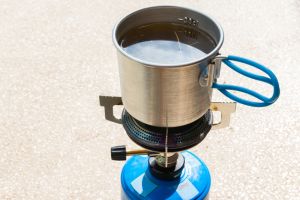 The answer turned out to be cereal and buttered bread, and tea made with water boiled on my camping stove. Unfortunately the stove was already low on gas and I didn’t have a spare canister for it, so there was no chance of using it to cook any actual meals. Before you’re in a similar situation, learn here how to build the oven that cooks without fire, fuel or smoke.
The answer turned out to be cereal and buttered bread, and tea made with water boiled on my camping stove. Unfortunately the stove was already low on gas and I didn’t have a spare canister for it, so there was no chance of using it to cook any actual meals. Before you’re in a similar situation, learn here how to build the oven that cooks without fire, fuel or smoke.
I decided that, after breakfast, I better drive into town and pick up a few more canisters. The power had already been out for over twelve hours and my optimism about it being back on soon was fading. I might need more gas, and I could pick up some easily-cooked food while I was in town.
That’s when the next problem appeared: The road hadn’t been plowed. I dug the car out anyway and tried it, but I was sliding all over the place before I was halfway down the driveway and there were a few places along the road where I knew the snow would have drifted deeper. I wasn’t going anywhere. I was going to have to survive with what I had in the house – and that wasn’t going to be fun.
And it wasn’t. I ate a lot of cheese sandwiches, and rationed myself to a couple of mugs of tea or hot chocolate every day. The house was cold enough that the refrigerator worked just as well without power, and I packed the contents of the freezer into garbage bags and buried them in a snowdrift.
Apart from that I spent most of my time on the couch wrapped in blankets; once a day I’d recharge my phone in the car, and take the chance to sit in there for an hour with the engine running and the heating going full blast, but with less than half a tank of gas left I had to ration its use.
Things Get Serious
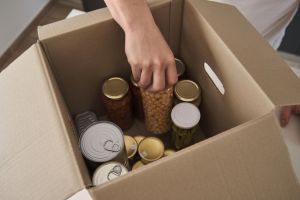 Days were cold and unpleasant, especially as my supplies of non-perishable food that could be eaten cold started to run low.
Days were cold and unpleasant, especially as my supplies of non-perishable food that could be eaten cold started to run low.
Related: I Tried to Eat My Emergency Foods and This Is What Happened
Nights were worse. The flashlight batteries were all gone on the second day, and I was down to the headlight.
Luckily I could recharge that along with my phone, and I did have a box of candles, but they needed to be used carefully because of the fire risk.
When the blackout finally ended, almost four days after it began, it was a huge relief. It was still cold, but I could heat the house again. I could make hot meals. Best of all, I wasn’t cautiously moving around a dark house. Civilization had returned.
The first thing I did was take a long shower now I had hot water again. Then I fired up the coffee machine. Next, I sat down to start work on a list of what I needed in case it happened again. I was about to become a prepper.
What Did I Learn?
I suffered badly through that blackout because I just wasn’t prepared for a crisis. I had some useful items – most of them in my camping gear – but the truth was I was totally unequipped for what happened.
I wasn’t ready to cook without power, so I was stuck with a small supply of food that could be eaten without cooking. I had no way of heating my home. I had no lanterns to give proper lighting. I didn’t even have a way to charge my phone without running the car.
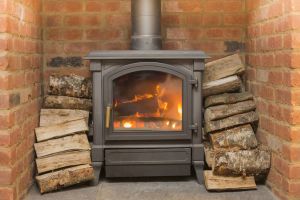 Since then, I’ve made some changes.
Since then, I’ve made some changes.
I’ve added a wood-burning stove that will keep the house warm, boil a kettle, or let me slow-cook in a Dutch oven.
Additionally, I’ve learned that under no circumstances should you burn these types of wood in a wood-burning stove.
I have a rechargeable LED lantern that will light an entire room reasonably brightly, and a couple of kerosene lanterns in case a blackout lasts longer and I can’t recharge the LED one.
Since I keep a big can of kerosene in the shed now I also got a kerosene heater for some extra warmth. As for food, I have a large stock of canned food that just needs reheated, as well as MRE-style meals that are even easier to prepare.
I now have a large first aid kit, and I always keep the car’s gas tank as close to full as I can. Just in case, there are four five-gallon gas canisters in the shed along with the kerosene.
Burning kerosene indoors carries risks, so I have new carbon monoxide detectors too. They’re battery powered, but that’s fine – I now have a lot of spare batteries, plus a couple of heavy-duty power banks that get their charge topped up weekly.
I’ve learned a lot from the experience of that blackout, and if another one (or some other crisis) happens, I’ll be a lot safer and more comfortable than I was last time.
You may also like:
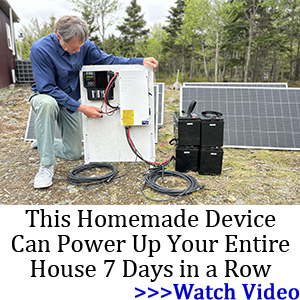 The Great Depression Was Nothing Compared to This
The Great Depression Was Nothing Compared to This
How to Avoid Being Targeted by Looters During a Massive Blackout (Video)
7 Guns Preppers Need to Buy Before the Upcoming Gun Ban
Foraging in Autumn: 10 Edible and Medicinal Plants You Need to Forage Before They’re Gone

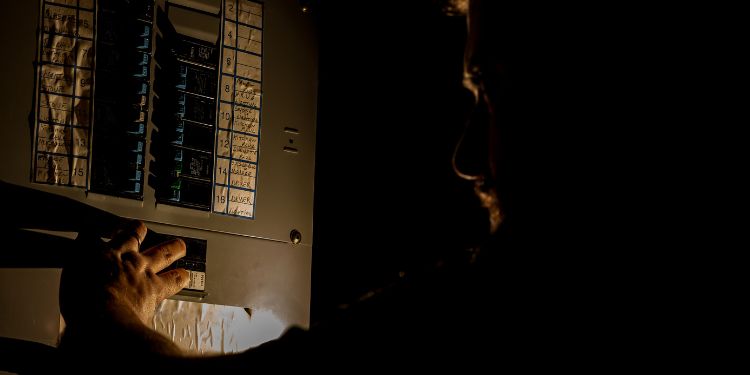













This is exacqly why we dont become complacient and say we are content with the system as it is .
Stand Firm
Stand on principle
Stand up against evil
Call out what is a lie and support what is Good
stand your ground against those who have no brain, clue, dei, woke , villiage idiot diversity hire s
Time is Now , Teach preparation , not complacency
Plan , Prepare, think like your sober , not fearful
reason out for your self , not the social media liar s networks
Olympics has gone WOKE!
Wait until Iran hits Israel with it’s new EMP bomb, America is next. We got a pedophile LGBT Pride parade done in the opening of the Olympics, the games are now considered trash, France blew it.
It’s bad enough with gay pride parades in America.
Maybe America deserves some push back on a blackout for sins of the fathers of alternative lifestyles.
There are no sins of the father anymore! That was removed by God in the Old Testament after He decided that man is accountable for his own sins! In Deu.24:16!
No more freedom in major cities run by liberals and useful idiots.
If things go wrong we will have 15 minute city limits. Be stuck in a cracker box condo or apartment, no gas powered car, no vehicle parking even for EV’s. You will only be using mass transit or ride a bike like a good Chinese peasant does.
My friend sent me a picture of one main road stretch in San Diego where there are bike lanes on both sides and no gas powered vehicle parking.
Funny thing is there maybe one bicyclist using a bike every three hours if city officials are lucky.
People have to drive around looking for rare parking spaces even for hard to get metered parking space.
Be lucky we don’t live there in California, land of fruits and nuts.
Some people wished they could have cancelled their votes for Bidenomics and the up coming no voter participating of Harris as a presidential candidate.
She won’t be it will be someone else, Newsom, Obama or Hillary as the up coming dark horse.
Blackouts are what we call a reset of our daily lives, get us back to reality of what our true values really are, once in a while.
Let’s see, during the 4 day Texas blackout with temps around 0 the whole time, my meals included, tenderloin and ribeye steaks, roasted chicken, grilled chicken, tempura shrimp and vegetables, biscuits and gravy, grilled salmon, pork ribs…because they were predicting the weather a week before it happened I stocked my garage fridge with fresh and frozen food and beer, bought extra propane for cooking and heat, charcoal for the grill, batteries for the LED lamps, split extra firewood, stocked the liquor cabinet with vodka and tequila, moved 25 gallons of water inside so it wouldn’t freeze. Didn’t touch any long term storage, 300 people died but we had a party.
Well, aren’t you a “smarty pants”? Good for you! I sure hope you helped a neighbor or two in there, though? Scriptures do say : A wise man sees danger coming and prepares for it or gets out of the way (My personal “translation”, but it’s close!)
I live in Texas where the power went out on very minor winds. Not just me. 10 counties and 4 million people out. It went down in sections not neighborhoods. Sections. I think it was either deliberate or hacked. It showed me once again water will be the issue. When the tap is off, that will be horrid. Literally one push of a button to anarchy. While I agree with the statements above, how do they help? deathocrats are a disease.
If anyone reading this has a system and want to share, a link or book or your trial and error please share. I once again need to make a water filter system to get water from the bayou. It’s stagnant and muddy. I need to make a filtering system. This and capturing water to begin with. Anyone have a tried and true outside filtering method? I can boil it or set in the sunlight but the initial cleaning is my hurdle. Any suggestions please?
Well, aren’t you a “smarty pants”? Good for you! I sure hope you helped a neighbor or two in there, though? Scriptures do say : A wise man sees danger coming and prepares for it or gets out of the way (My personal “translation”, but it’s close!)
Your filtering issue needs a lot of thought for sure, and I am no expert. BUT I WILL SAY, have you thought of using Glen Meder’s product? I think it’s called survival still or something similar. You put the nasty water in a huge pot and boil it until it condenses on his product. The condensate then runs off into your collection vessel for drinking. THAT would NOT provide you enough drinking water, plus water for bathing, plus water for cleaning, but it’s definitely a start if you can access some fuel for boiling the water. I hope you find something that can filter larger quantities of water, like you wish to. Another thing is you could always buy the product called “water bricks” that you fill with water for storage! We bought 14 of them(!) and I am still looking for more space so I can buy more and store more water. I love those water brick “suckers”…so comforting to know the nice amt. of water we’ve been able to store, but you must also use a product to keep the water fresh for years. Best of luck to you!
To filter muddy water, you can use a millbank bag. You can also use a tee shirt or sheet. If you have say a wash tub, stretch the shirt or sheet over that. Find a way to secure it tightly enough so it doesn’t just fall into the tub when you pour the muddy water you have. You could put a screen across first then the shirt or sheet on top of the screen. Pour the muddy water next. It’ll probably take a while to drip through, and you might have to pour some of the water in one area of shirt or sheet then switch to another.
Also if you can draw the water into a bucket and allow it to sit for a bit, you’ll be able to draw off clearer water as the mud and silt will sink towards the bottom.
Ideally, allowing the water to sit in the bucket and then drawing it out carefully and filtering it into another vessel covered with the tee shirt or sheet will remove most of the debris and silt or mud.
Depending upon your results, you might want to allow another shirt/sheet fikteri g into another vessel before you go for the purification step.
Pouring muddy water over gravel and allowing the water to drop through can also capture some debris and mud, and that might work better for you.
Using the shirt/sheet drip method isn’t fast, and it seems as if the cloth quickly clogs and the drips take forever to get through.
Any step you can take to remove the debris or silt before you try purifying will be a great help though.
Hope this helps.
Bayou water? Stagnant. Per my First Need water filter instructions, stagnant water is preferred because a lot of the particulates have settled out. I have consumed water from the Big South Fork River backpacking, after prefiltering any large particles out through a coffee filter and then treating with iodine drops and giving the iodine time to work. At other times, I have used the MSR Waterworks or First Need filtration systems. Both of those will need regular maintenance to keep the filters clean – when they start to plug you are pumping a lot for a very little amount of water. The dialysis-type membranes (I think Sawyer sells them) look promising, but I have not tried them out.
I prefer 2 methods in combination to purify water and make sure it is doubly safe: chemical treatment plus time, boiling, fine filtration, distillation. Ultraviolet light exposure is also a possibility. 2 of those.
By fine filtration, I don’t mean a survival straw. There are 2 such straws sold, and one is finer than the other.
Since I’m in TN, I do want to have a good still for water – you want that if you are trying to make floodwaters (with remnants of oil, gasoline, and sewage in it) drinkable or take the salt out of salt water.
I advise you to look up the sizes of viruses, bacteria, amoebae, and other microorganisms before you consider what size filtration and what treatment you want to go with.
We heat with wood and are backed up with K1 FHA. Our 275 gallon tank will keep our kerosene lamps going for decades and our India pump single burner kerosene stove will assure us of fresh hot coffee and meals. Having an outside wood fired oven is a blessing. For you guys with a deep well, a 12 volt submersible pump and a marine battery charged by a solar panel will do the trick. Many folks but their firewood annually, and that’s ok if you have a 3 to 5 year supply drying. Can’t say enough about storing garden seeds in an ammo box. Candles and canning supplies come cheap at yard sales. One thing we gain from our mistakes is wisdom, but isn’t it more prudent to learn from someone else’s mistakes?
Solar panels will not work when they keep the skies cloudy all the time, which is there plan!!
Good thoughts in the article. One item to consider, Kerosene has a 5 year shelf life IF stored in near perfect conditions. Propane, on the other hand, has an INDEFINITE shelf life. I recently found a 1LB canister from the 1980’s in a cabin I was cleaning up. I called Coleman, because I didn’t want to take any chances. They told me, that as long as the canister was in good shape (no rust, dents, etc), it would be fine. And, it was! So, as an emergency fuel, Propane is my choice!
As an aside, while I like the articles on this website, I really hate the comments section. It seems that the comments, almost immediately, get hateful, denigrating, and completely unrelated to the article at hand. Perfect example here is a comment about “Olympics gone woke”. Can’t see how this has anything to do with this topic? I would much prefer to read about other people’s experiences with how to deal, as this article does, an extended power outage. In my part of the country, cold is less of an issue than very hot temperatures, and I think that is harder to prepare for. How do you stay healthy, and keep your food safe in 100+ degrees? THAT’S an article I’d love to see!
Prepping and politics go together, Survivalist movement of the 1970’s was based on current politics. No different in today’s world, otherwise what are we really preparing for?
Been fully prepped for decades…multiple sources of power, cooking, water, etc. Nowadays I just sit back and keep loading mags as that’s all that’s left to do.
The old boy scout motto “Be Prepared” applies to this life we are living right now more than anytime in my 74 years. Instead of sharing with my son, I have recently purchased things he will need, and given them to him … as he is of the mind set … it can never happen in America.
I personally have 180+ gallons of water saved, about 4 months of 4 patriots freeze dried food stuffs (for 4 people) so feeding just myself (living alone) I got food for a year. A couple solar batteries and panels, and adding some soon to a back yard shed. Plus of course, canned goods, 100’s of batteries, currently only a dozen propane canisters … over 2000 rounds of ammo for each pew pew I own.
I take this all quite seriously. Not to mention, that I have a supply of cash, and precious metals, in a rugged gun safe … for purchasing power or barter. Plus a lot of seeds for planting.
Never stack wood up against a woodburning stove as pictured above in this article. The wood will get hot and ignite. This photo is the craziest thing I have seen.
That isn’t the craziest thing I’ve ever seen, but it definitely isn’t a good idea.
The Asian Butane cartridge stoves single burner were very useful a couple of years ago during that infamous Texas Brown Out some years back. Only a single burner but for a family of four, very useful when meal times occurred. I’m not a coffee addict but my wife is and a large thermos (keep several of these, this or larger mouth insulated food thermos) so that we weren’t constantly having the stove on. These DO provide fumes, so be extra careful where you prepare your meals. The tail gate of my truck under the car port made for an expedient food prep table. These stoves are about a foot square and their cartridges cost about $2 a piece. They provide about an hour and a half of cook time, more if the heat isn’t required to be set on high constantly.
You can sleep under plastic tarps to store heat, but the condensation from body heat will eventually soak your bag
Thanks for the useful feedback content above and for the original post itself.
If you have the time – you can build a still like that for booze but use it to distill water for drinking. use a screen to filter big stuff then your shirt for little stuff then still for safety and purification. I built a copper still that looks like the old timers type but use it to make distilled water that I store up for later use. I start with rain water from a barrel. Don’t wait until there is an emergency to get something worked out for water. It can leave you in a real bad spot.
We are too accustomed to the comforts of modern life, my father was a prepper before that word existed! He taught us to be prepared for an emergency situation. I remember when I was a child and a storm in the middle of summer left us without electricity for a week. My father improvised lights with a motorcycle battery and at night we slept outside. Of course, those were different times. , an America that I no longer recognize!!!